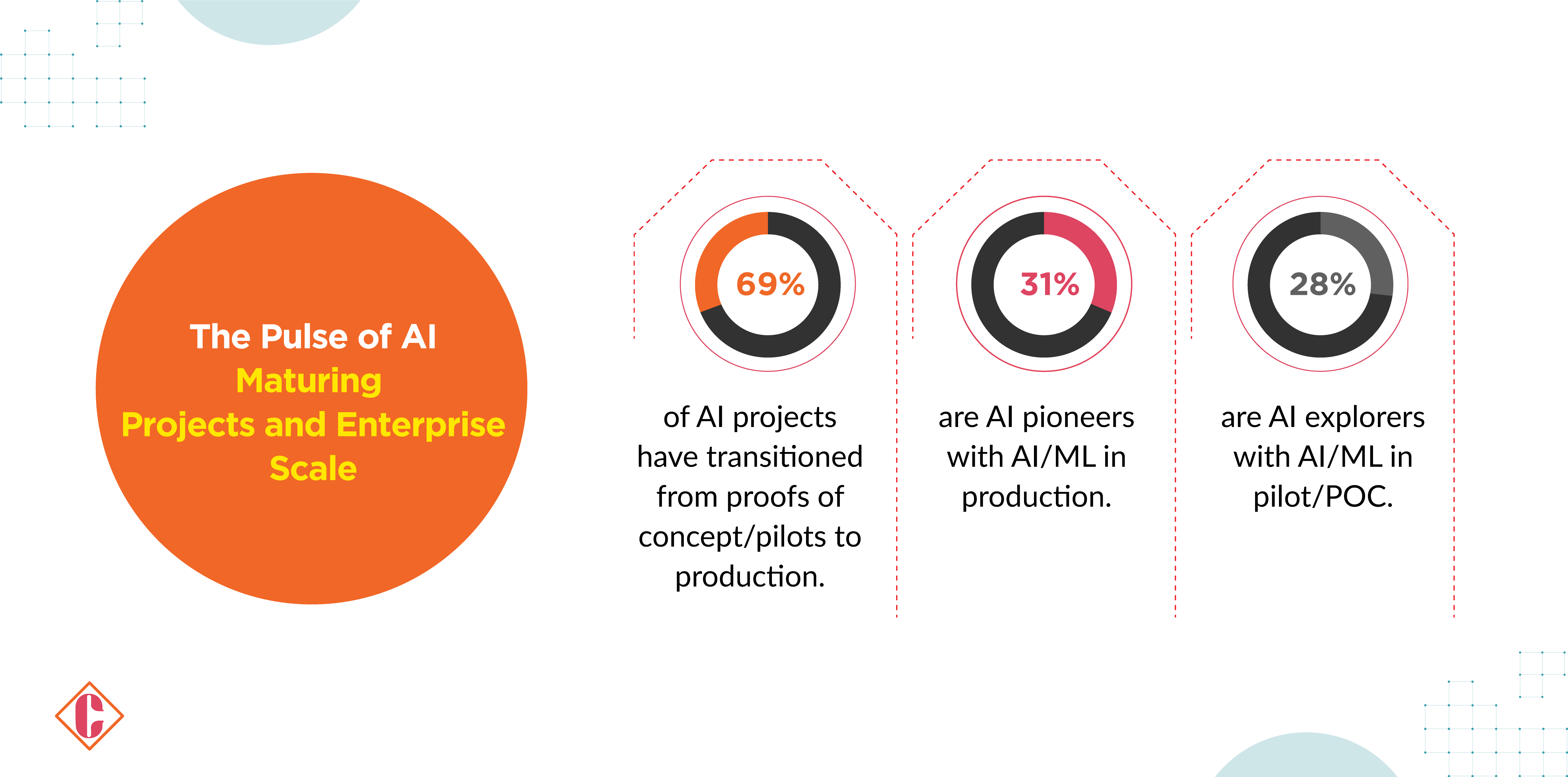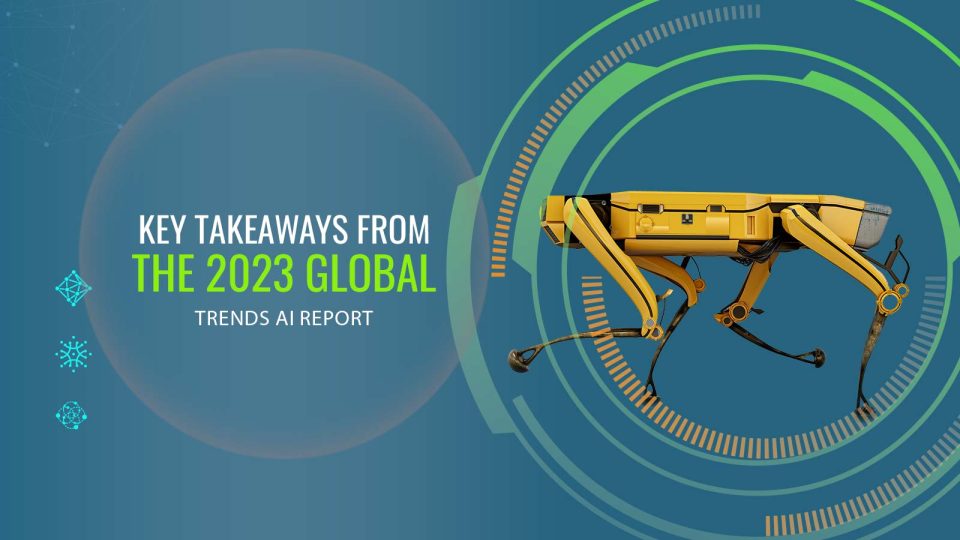The future of AI in business centers on human-machine collaboration. AI manages repetitive tasks and automates processes, enabling humans to concentrate on creativity, strategy, and complex decision-making. The evolution of AI continues. It is essential for B2B businesses and tech-forward C-suites to know about AI Trends. This article provides an overview of the 2023 Global Trends AI Report guiding smart investments, risk management, and innovation. Loaded with insights on current trends and future directions, it empowers leaders to guide their organizations toward AI-driven success. The report was crafted by S&P Global Market Intelligence and commissioned by Weka. It provides a comprehensive snapshot of the current AI landscape.
Insights from the 2023 AI Trends Report:
- 69% of organizations have transitioned from AI pilot projects to implementing initiatives at an enterprise scale.
- AI has transformed from a cost-saving measure to a significant revenue driver, as indicated by 69% of respondents focusing on revenue-driven motivations.
- Organizations encounter challenges as AI matures, with data management being a major impediment, identified by 32% as the primary technical inhibitor, surpassing security and compute performance concerns.
- AI pioneers adopt a hybrid approach, utilizing an average of 3.2 locations for training.
- 68% express concerns about the impact of AI/ML on energy use and carbon footprint, with the cloud viewed as a crucial solution by 74% for achieving greater AI sustainability.
- The report emphasizes the direct impact of aging data infrastructures on sustainability performance, acknowledged by 77% of respondents. Organizations with modern data architectures are highlighted as better positioned to lead in AI/ML advancements.
Takeaways from the 2023 Global Trends in AI Report
#1 AI Adoption and Organizational Impact
AI has transitioned from an emerging technology to a core component of business transformation on a global scale, with a significant number of organizations moving beyond pilot projects to embed AI into their core business processes. This reflects a maturation of AI technology and its integration into enterprise operations, indicating widespread adoption across various industries and regions. The trend shows a shift towards leveraging AI for top-line growth and innovation, marking its importance in the competitive business landscape.

#2 AI as a Driver of Business Transformation
- Environmental Consequences and Challenges: AI/ML’s green solutions have environmental consequences, notably carbon emissions from training models like GPT-3. Striking a balance between AI’s benefits and environmental costs is crucial, given impending regulations.
- AI’s Infrastructure Role: AI enhances infrastructure efficiency with automated provisioning, workload optimization, and task automation. AI pioneers recognize the public cloud’s sustainability impact, with 40% emphasizing its critical role compared to 25% of AI explorers.
- Infrastructure Modernization and Sustainability: Modernizing infrastructure, especially in high-performance computing (HPC), is vital for sustainability (84% importance). Widely implemented AI significantly impacts sustainability through data architectures (53%).
- Infrastructure Challenges with AI Scaling: Non-optimized IT infrastructure is a bottleneck as AI scales. Challenges include high transition costs (46%) and program initiation (45%). Initial investments in IT and data infrastructures are crucial for future growth and sustainability.
- Enterprises with Optimized Data/Infrastructure: Enterprises with modern data architectures, often through the public cloud, are poised as future AI leaders. Modern data architecture facilitates seamless data exchanges between locations, which is essential for scaling AI in production.
- Regional, Industry, and Size Variations: AI value varies by region, industry, and size. Larger enterprises encounter challenges in AI projects despite resources. Regionally, North America leads in AI pioneers (77%), followed by Asia-Pacific (69%), and Europe, the Middle East, and Africa (61%).
#3 Challenges in AI Implementation
#4 Global and Regional AI Trends
The impact and value of AI investments exhibit distinct variations shaped by company size, regional dynamics, and industry specifics. Notably, organizational size significantly influences the challenges encountered in scaling AI initiatives. While equipped with extensive resources, larger enterprises grapple with heightened complexities, including legacy system constraints, change management hurdles, and securing stakeholder buy-in. This pattern is evident in the adoption rates, with 58% of organizations in the $100 million-$499 million revenue bracket having AI in production, rising significantly to 82% for those with $500 million-$5 billion, and stabilizing at 76% for organizations with $5 billion and above in revenue. Regional disparities in AI impact are discernible and influenced by geopolitical factors, support for free markets, regulatory environments, and talent accessibility, among other determinants.
#5 The Future of AI: Predictions and Trends
The future of AI is characterized by its evolution from primarily being a cost-saving tool to becoming a catalyst for generating new revenue streams and redefining market dynamics. The focus is increasingly on the innovative application of AI in developing new products, services, and business models. This evolution necessitates reevaluating data management and IT infrastructure to support the burgeoning requirements of advanced AI technologies, especially generative AI, which presents both opportunities and computational challenges.
#6 Recommendations for Businesses
To fully harness the potential of AI, businesses are advised to align their AI strategies with their overall organizational objectives. Investing in modern data architectures and hybrid cloud environments is recommended to support AI technologies’ diverse and evolving needs. This strategic alignment facilitates scalability and ensures businesses are well-positioned to leverage AI for various purposes, including sustainability efforts, operational efficiency, and achieving a competitive edge in the market.
Conclusion
The 2023 Global Trends in AI Report underscores a pivotal moment where AI is no longer a distant future but a present reality, urging businesses to adapt swiftly to harness its transformative potential. It reveals a landscape where organizations, particularly “AI pioneers,” are primed with optimized infrastructures and streamlined data management, ready to explore AI’s capabilities beyond mere cost savings. These businesses stand at the forefront, leveraging AI for sustainability and new revenue streams, indicating a critical shift towards viewing AI as a key driver for long-term growth. The report emphasizes the importance of immediate action, the integration of sustainability into AI strategies, and the necessity for scalability in infrastructure to accommodate diverse AI applications.
FAQs
1. How is AI driving business transformation in the B2B sector?
AI is rapidly becoming a catalyst for business transformation in the B2B sector by integrating into workflows and value propositions, with 69% of organizations having at least one AI project in production. AI is moving beyond pilot projects, driving significant business value through enterprise-scale implementations.
2. What future predictions can be made about AI’s impact on the B2B industry?
The report indicates a future where AI continues accelerating across industries, emphasizing revenue generation over cost savings. Organizations are expected to leverage AI for top-line growth, rapidly driving market evolution.
3. What recommendations are given for B2B businesses to leverage AI effectively?
B2B businesses are advised to modernize their IT infrastructure and data architectures to accommodate AI workloads across multiple deployment venues. Emphasizing data management and leveraging a hybrid approach for AI/ML workloads can support the demands of AI applications.
4. How does AI adoption vary across different B2B industries and regions?
AI adoption varies significantly across industries and regions, with differences in the scale of AI projects and their impact on business value. Company size, geopolitical forces, regulatory environments, and access to talent influence the adoption rate.
5. What are the key factors for successful AI integration in B2B companies?
Successful AI integration in B2B companies involves a combination of optimized infrastructure, modern data architectures, and a strategic approach to scaling AI projects. Key factors include focusing on data management as a primary technical inhibitor, leveraging hybrid and multiple deployment locations, and addressing sustainability concerns related to AI’s energy use and carbon footprint.
6. How can B2B companies prepare their IT infrastructure for AI adoption?
Preparation involves modernizing IT and data infrastructures to support the volume and complexity of AI workloads. This includes transitioning to cloud and hybrid environments, investing in high-performance computing, and ensuring data architectures can efficiently manage the lifecycle of AI applications.
7. What role does data management play in AI implementation for B2B businesses?
Data management is crucial for AI implementation, serving as the top technical inhibitor to AI/ML deployments. Effective data management strategies are necessary to address data sourcing, preparation, standardization, and governance challenges.
8. What challenges might B2B companies face in adopting AI, and how can they overcome them?
Challenges include data management complexities, the need for high computational power, and sustainability concerns. Overcoming these challenges involves investing in modern data architectures, exploring hybrid cloud solutions, and focusing on sustainable AI practices.
9. How can B2B companies measure the impact of AI on their organization?
Measuring AI’s impact involves assessing its role in driving revenue growth, operational efficiencies, and sustainability outcomes. Organizations should track performance against these key areas, leveraging AI/ML to optimize operations, enhance product and service quality, and achieve sustainability goals.
[To share your insights with us as part of editorial or sponsored content, please write to sghosh@martechseries.com]


